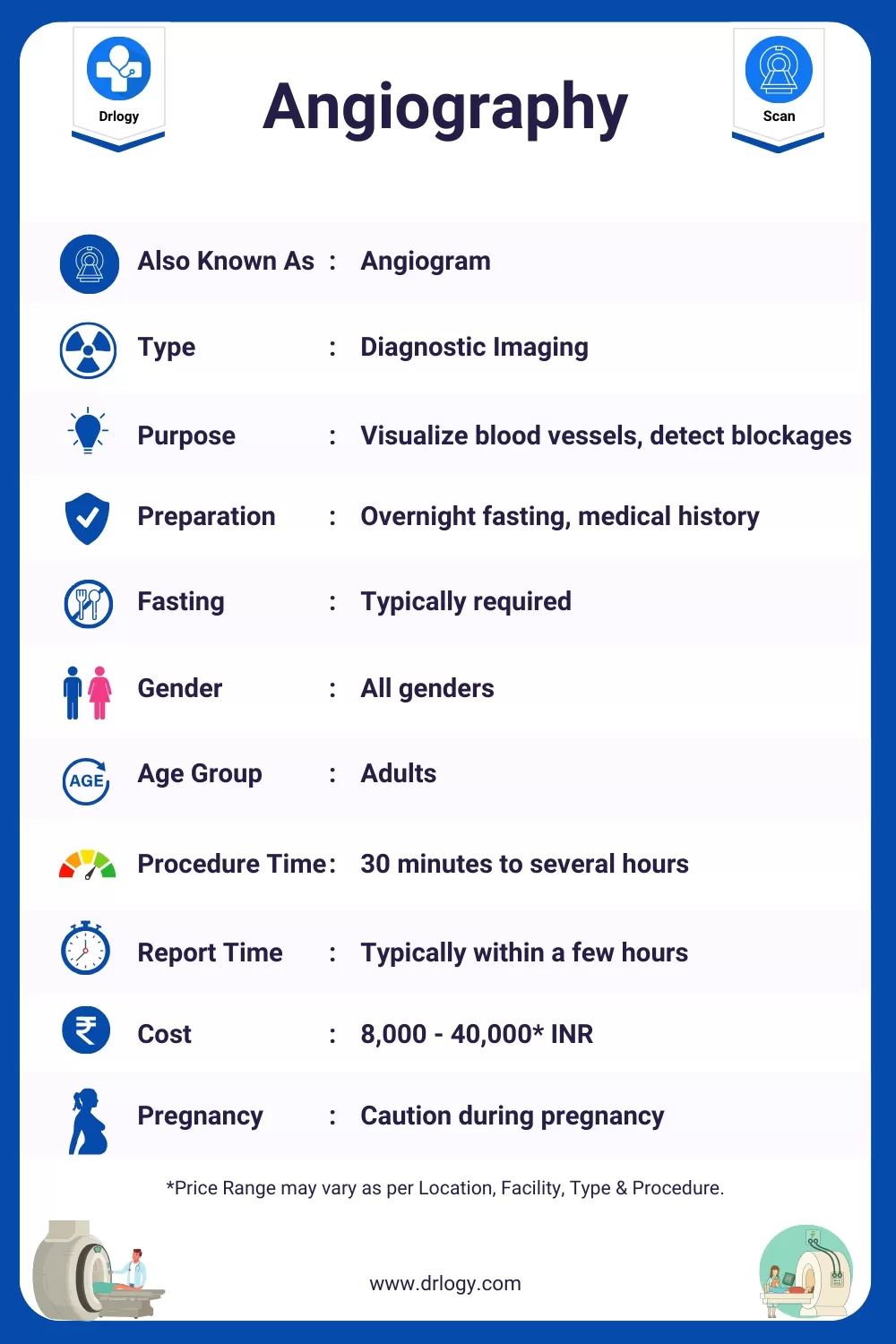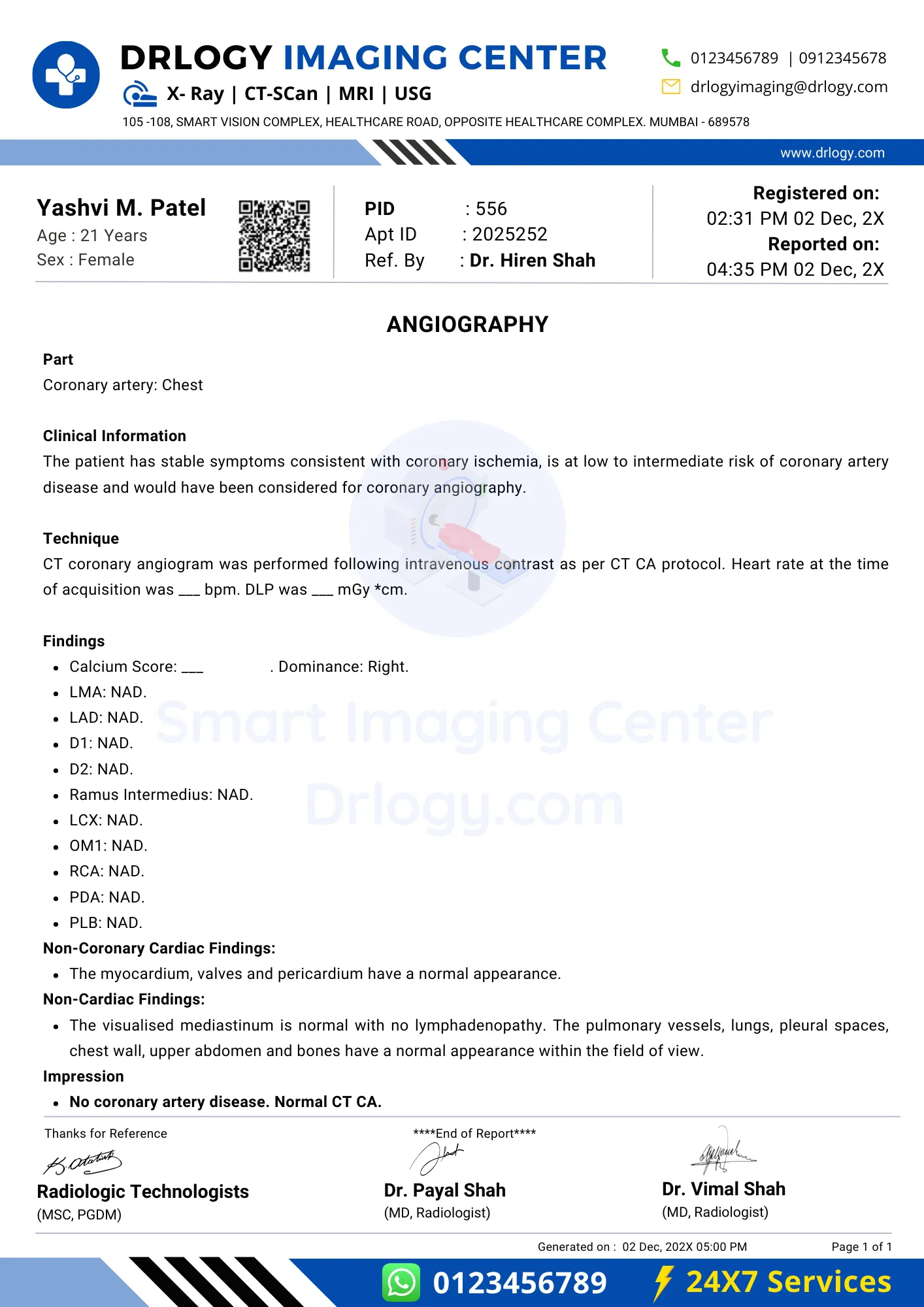
Angiography is a medical procedure that involves injecting a contrast dye into blood vessels and using X-rays to create images of the blood vessels, helping doctors diagnose and treat conditions like blockages or aneurysms.
Angiography is a medical procedure.
Here are the basic details for the Angiography .
| Also Known As | Angiogram |
| Type | Diagnostic Imaging |
| Purpose | Visualize blood vessels, detect blockages |
| Preparation | Overnight fasting, medical history |
| Fasting | Typically required |
| Gender | All genders |
| Age Group | Adults |
| Procedure Duration | 30 minutes to several hours |
| Reporting Time | Typically within a few hours |
| Cost | 8,000 - 40,000* INR |
| Pregnancy Consideration | Caution during pregnancy |
| Risks and Safety | Minimal risks, contrast allergy risk |
| Accessibility | Available in specialized centers |
*Price range may vary as per location, facility, type, and procedure.
Here are common reasons for Angiography.

Here are the types of angiography along with their primary use.
| Angiography Type | Organ/System | Primary Use |
|---|---|---|
| Diagnostic Angiography | Blood vessels | Evaluate blood vessel abnormalities |
| Coronary Angiography | Heart | Assess coronary artery blockages |
| Cerebral Angiography | Brain | Examine brain blood vessels |
| Peripheral Angiography | Extremities | Visualize peripheral blood vessels |
| Pulmonary Angiography | Lungs | Assess pulmonary artery condition |
| Renal Angiography | Kidneys | Evaluate renal artery abnormalities |
| Aortic Angiography | Aorta | Examine the aorta and its branches |
| Cardiac Catheterization | Heart | Guide cardiac interventions |
These angiography types serve diverse diagnostic purposes across different organ systems.
Here is the basic preparation before, during, and after Angiography for any patient.
Note that specific instructions and procedures may vary depending on the type of angiography and your individual medical condition. Always follow the guidance provided by your healthcare team for a successful and safe angiography procedure.
| Professional | Role |
|---|---|
| Interventional Radiologist | Performs angiography procedures. |
| Radiologic Technologist | Assists during the procedure and operates equipment. |
| Radiology Nurse | Assists with patient care during angiography. |
The procedure for Angiography typically follows these steps:
Here are some common elements you might find in a Angiography report:
| Angiography Findings | Interpretation |
|---|---|
| Blood Vessels Examined | Normal or Abnormal |
| Specific Vessel Observations | Description of any abnormalities, such as blockages, stenosis, aneurysms, or vascular malformations |
| Blood Flow Assessment | Evaluation of blood flow, velocity, and direction |
| Use of Contrast Material | Details about the use of contrast agents, if applicable |
| Impression | Summary of key findings or diagnostic impressions |
| Recommendations | Follow-up tests, treatments, or interventions, if necessary |
| Conclusion | Final remarks or clinical recommendations |
Angiography is a dynamic imaging technique used to visualize blood vessels, and the results are typically discussed with the healthcare provider during or immediately after the procedure. Any abnormal findings would be addressed promptly, and appropriate next steps would be determined based on the clinical context.
Here is potential causes of abnormal angiography results:
| Abnormal Angiography Finding | Potential Causes |
|---|---|
| Vascular Narrowing (Stenosis) | Atherosclerosis, plaque buildup, vasculitis |
| Blocked Blood Vessel | Thrombosis, embolism, arterial dissection |
| Aneurysm | Weakening of the blood vessel wall, congenital abnormalities |
| Vascular Malformation | Congenital malformations, arteriovenous malformations |
| Abnormal Blood Flow | Vascular obstruction, shunts, collateral vessels |
| Contrast Extravasation | Vascular injury, rupture, or leakage |
Abnormal angiography findings can have various causes, and further evaluation and management depend on the specific findings and the patient's clinical condition. These results are typically interpreted by a vascular specialist or interventional radiologist who can determine the appropriate course of action.
The duration of an angiography procedure can vary depending on the specific type of angiography and the complexity of the examination. Here's a general overview of the approximate time it takes for different types of angiography procedures:
| Angiography Procedure | Duration |
|---|---|
| Diagnostic Angiography | 30 minutes to 1 hour |
| Coronary Angiography | 30 minutes to 1 hour |
| Cerebral Angiography | 1-2 hours |
| Peripheral Angiography | 30 minutes to 1 hour |
| Pulmonary Angiography | 30 minutes to 1 hour |
| Renal Angiography | 30 minutes to 1 hour |
| Aortic Angiography | 30 minutes to 1 hour |
| Cardiac Catheterization | 1-2 hours (including angiography) |
- Please note that these are approximate times and can vary based on factors such as the complexity of the blood vessel network being examined, the patient's specific condition, and the need for additional procedures during angiography.
- Additionally, some angiography procedures may require sedation or anesthesia, which can extend the total procedure time.
- Always follow the guidance provided by your healthcare provider for your specific angiography procedure.

Here are some limitation associated with a Angiography.
Here are some risk factors associated with a Angiography
| Myth | Reality |
|---|---|
| High radiation risk | Controlled exposure |
| Unsafe for all ages | Used with precautions |
| Painful procedure | Generally well-tolerated |
| Dangerous for heart | Commonly used in cardiac |
| Permanent damage | Short-term radiation |
| Risky for everyone | Risk assessment done |
| No operator error | Operator skill crucial |
Here are the estimated Angiography Price in India with different top cities:
| City | Price Range (INR)* |
|---|---|
| Mumbai | 8,000 - 40,000 |
| New Delhi | 9,000 - 40,000 |
| Bangalore | 8,000 - 40,000 |
| Hyderabad | 9,000 - 40,000 |
| Kolkata | 8,000 - 40,000 |
| Pune | 9,000 - 40,000 |
| Lucknow | 8,000 - 40,000 |
| Noida | 9,000 - 40,000 |
| Surat | 9,000 - 40,000 |
| Gurugram | 8,000 - 40,000 |
| Patna | 8,000 - 40,000 |
| Chennai | 9,000 - 40,000 |
| Jaipur | 9,000 - 40,000 |
| Ahmedabad | 8,000 - 40,000 |
*Prices are approximate and range may vary as per location, facility, type, and procedure.
Summary
Overall, Angiography is a vital diagnostic tool for visualizing blood vessels and guiding medical interventions with controlled radiation exposure and operator expertise. Also check Drlogy Test for detailed information about all medical tests for patients, doctors, scholers and medical students.
Reference
DOCTOR'S MOST TRUSTED HEALTHCARE PLATFORM
10M+
Patients
30000+
Doctors
25000+
Hospitals/Labs